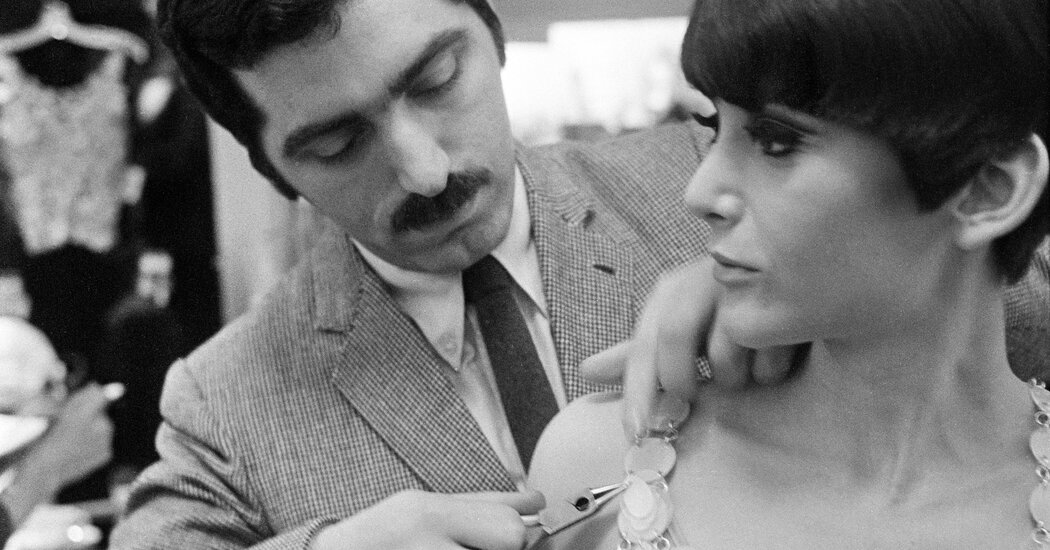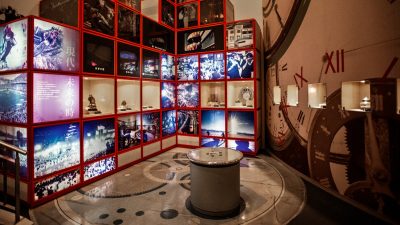Paco Rabanne, the Spanish designer whose futuristic creations gave shape to the dreams of the space age and redefined couture, died on Friday in Portsall, France. He was 88.
His death was confirmed by Puig, the luxury group that owns the brand. No cause was given.
“Paco Rabanne made transgression magnetic,” Jose Manuel Albesa, the president of the beauty and fashion division at Puig, said in a statement. “Who else could induce fashionable Parisian women to clamor for dresses made of plastic and metal?”
Mr. Rabanne’s career was a moon shot unto itself. He burst onto the French fashion scene in 1966 with a collection called “Manifesto: 12 Unwearable Dresses in Contemporary Materials” and chain-link minidresses composed of hundreds of plastic and metal disks. Three years later he introduced his first perfume, called Calandre (the name means “car grill”), which became the basis of a fragrance empire.
He costumed Jane Fonda in the 1968 sci-fi film “Barbarella,” eschewed needles and thread for pliers (he once said that “sewing is slavery”) and made chain mail into a fabric. Experimentation and scent were the twin pillars on which his brand was built. They made his name resonate far beyond the salons of Avenue Montaigne and would go on to influence the work and business plans of generations of designers.
In ranging wide over new frontiers in fashion, Mr. Rabanne also explored some equally far-out beliefs. He believed he had seen God three times, been visited by aliens and had numerous previous lives, including one in which he was a prostitute during the reign of Louis XV and one in which he murdered Tutankhamen. He predicted that the Russian space station Mir would fall on Paris. The New York Times once described him as “futurist, couturier, mystic, madman, Dadaist, sculptor, architect, astrologer, perfumer, artist and prophet.”
Salvador Dalí simply called him the second genius of Spain.
In 1997, Mr. Rabanne published a book entitled “Journey: From One Life to Another.” But, in fact, his own life was an epic unto itself.
Francisco Rabaneda y Cuervo was born on Feb. 18, 1934, in Pasajes, near San Sebastián, Spain; he later adopted Paco Rabanne because it was 11 letters long, which he thought was a felicitous number. His father was a colonel who was executed during the Spanish Civil War, and in 1939 his mother, the head of tailoring for the designer Cristóbal Balenciaga, fled with her young son to France.
Mr. Rabanne studied architecture at the École Nationale Supérieure des Beaux-Arts, but was attracted to fashion because it was less restrictive. He paid for his studies by designing jewelry and buttons for couturiers like Christian Dior and selling sketches to Charles Jourdan.
It was his embrace of unconventional materials, however, that would make his name, and his perfumes that would finance it.
His couture debut in 1966, complete with hair by Vidal Sassoon, shocked the French fashion world. “They were shivering in terror!” Mr. Rabanne told The Times. “It was difficult for them because they saw clothes that they couldn’t understand.”
Still, his clothes struck a chord with American fashion editors as well as celebrities, and they were soon being worn by Françoise Hardy, Brigitte Bardot and Jane Birkin.
He continued to innovate, creating a collection of paper dresses held together by multicolored Scotch tape in 1967, the year The Times credited him with establishing “a new kind of awesome chic.” He later included Velcro, aluminum and fiberglass in his work. Coco Chanel dismissed him as “a metal worker,” but, he explained, “I wanted to turn women into modern warriors.”
His clothes represented the possibility of escaping gravity, in all meanings of the word. As he told The Times, “Man hasn’t changed his uniform for 100 years.” But, he said, “Women have been freed.”
His imaginative approach attracted the attention of filmmakers, and he was enlisted as a costume designer for movies, including Jean-Luc Godard’s “Two or Three Things I Know About Her” and William Klein’s “Who Are You, Polly Maggoo?”
It also caught the eye of Puig, which helped Mr. Rabanne introduce his first scent, Calandre. Like his fashion, Calandre was a combination of disparate elements that were not supposed to work together but, in his hands, did.
It was followed four years later by Paco Rabanne Pour Homme, which gave rise to a veritable flood of scents, including Metal, La Nuit, Sport and XS. In 1981, he introduced home furnishings; in 1983, a ready-to-wear line for men; in 1990, women’s ready-to-wear. At one point he had signed 140 licenses.
Mr. Rabanne retired in 1999, though Puig continued to release new fragrances under his brand, most famously 1 Million, which he had helped create. The company temporarily put the ready-to-wear line on hiatus, only to revive it in 2011 under the creative direction of Manish Arora, followed by Lydia Maurer and then by Julien Dossena, the current designer, who took over in 2014.
Information on his survivors was not immediately available.
The author of a number of books about his paranormal beliefs, including “Has the Countdown Begun? Through Darkness to Enlightenment” (1994) and “The Dawn of the Golden Age: A Spiritual Design for Living” (1999), Mr. Rabanne was made an officer of the Legion of Honor in 2010. The London Museum of Design named his 1969 Skyline chain-link bag one of “50 Bags that changed the world.”
“I know that I will always have a place in the history of fashion,” Mr. Rabanne once said. “I am in all of the dictionaries because I introduced new materials to the world of fashion. To have created the first dresses in metal, paper, molded plastic — that is my legacy.”
Sumber: www.nytimes.com










